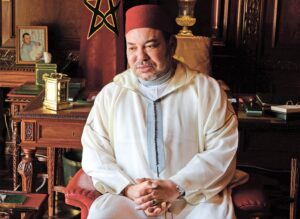Dakhla Atlantic Port: Morocco's gateway to Africa and a pillar for consolidating sovereignty over the southern regions.

The project is considered Dakhla Atlantic Port One of the most prominent structural projects Morocco intends to implement as part of the royal vision for developing the southern regions and strengthening the Kingdom's position as a strategic link between Europe and Africa. The project transcends its purely economic dimensions, embodying a strategic tool for consolidating national sovereignty, achieving African integration, and activating the South-South partnership.
In his speech to the nation on November 7, 2020, marking the 45th anniversary of the Green March, His Majesty King Mohammed VI emphasized the importance of this project, noting that Morocco “has completed the demarcation of its maritime zones, within the framework of national law and in accordance with the principles of international law.” The King also emphasized “the Kingdom’s commitment to dialogue with neighboring Spain regarding overlapping maritime zones, within the framework of the Law of the Sea and respect for the bilateral partnership,” affirming that “clarifying the boundaries of maritime zones will support the vision aimed at enhancing economic and social dynamism, and that the Atlantic coast of the southern provinces will be a platform for economic integration and continental and international influence, alongside the port of Tangier Med, which occupies a leading position in Africa.”
According to official Moroccan data, the cost of the Dakhla Atlantic Port project is estimated at approximately 12.5 one billion Moroccan dirhams (equivalent to US$1.2 billion), financed by the Moroccan state and multiple partnerships. The port will be built 40 kilometers north of Dakhla (the city is located on a narrow peninsula in southern Morocco, surrounded on three sides by the Atlantic Ocean. Dakhla is a unique tourist destination that combines the beauty of the desert landscape with the splendor of coastal beaches. The city is known for its moderate climate throughout the year), and will include three main poles: a commercial pole, another dedicated to marine fishing, and a third directed towards industries and logistics services.
The port is of great strategic importance to both the Dakhla-Oued Eddahab region and West Africa in general, as it is expected to contribute to the region's economic, social, and industrial development across various productive sectors, such as fishing, agriculture, mining, energy, tourism, trade, and manufacturing. It is also expected to provide a modern and advanced logistics infrastructure to accommodate the growing demand for maritime transport services at the regional and international levels.
Despite the concerns expressed by some of Morocco's opponents, both separatist movements and some neighboring countries that view the project as a potential threat to their maritime and commercial interests, the Kingdom of Morocco continues to implement the Dakhla Atlantic Port project at a steady pace, driven by a comprehensive strategic vision aimed at consolidating its maritime leadership and strengthening its geo-economic position in the Sahel and West Africa..
The Dakhla Atlantic Port is a pivotal pillar in Morocco's plan to diversify its maritime gateways and reduce dependence on northern ports by turning its attention to the African continent. The project is expected to bring about a structural transformation in the economic landscape of the Dakhla-Oued Eddahab region through a number of expected structural impacts, including:
1- Creating thousands of direct and indirect job opportunities:
The project is expected to contribute to the creation of extensive job opportunities, both during the construction phase and after its entry into operation, by employing workers in the fields of construction, marine works, technical management, monitoring, transportation, and port-related services. Associated industries, such as fishing, storage, packaging, and transportation, will also provide extensive employment opportunities for local human resources, contributing to reducing unemployment and raising the standard of living for the region's population.
2- Enhancing export capabilities, especially in marine and agricultural products:
The port's advanced infrastructure will facilitate the export of the region's abundant seafood, particularly high-quality fish, to markets in West Africa, Europe, and Latin America. The port's connection to agricultural distribution chains will also enable the region's agricultural products to be marketed under ideal conditions for refrigeration, storage, and processing, enhancing its competitiveness in international markets.
3- Development of industries related to refrigeration, packaging, and logistics services:
The project will provide a favorable environment for the emergence and development of complementary industries, including refrigeration and freezing units, packaging plants for marine and agricultural products, as well as logistics platforms specializing in container handling, smart warehousing services, and multimodal transport. This will contribute to the creation of an integrated economic system (Écosystème logistique) that will transform Dakhla into a pivotal industrial and logistics hub in the south of the Kingdom.
4- Integrating the southern regions into regional and global production chains:
Connecting the port to the national road network, and later to the railway network, will make Dakhla an important logistics hub connecting northern Morocco with Central and West Africa. This territorial integration will enable the southern regions to be integrated into continental and global supply and production chains, placing them at the heart of the region's economic dynamics and giving them an active role in cross-border trade.
The port will also contribute to connecting Morocco to landlocked African countries, such as Mali, Niger, and Burkina Faso, via a land-sea transport corridor, strengthening its position as a logistics hub for the continent. The project complements other initiatives such as the Tiznit-Dakhla Expressway, a future railway line, and the Port of Nouakchott in Mauritania.
The Dakhla Atlantic Port project encompasses multiple, interconnected strategic dimensions that go beyond being a maritime facility. It reflects a comprehensive development vision aimed at repositioning Morocco within the regional and international trade system and enhancing its openness to its African hinterland. The project also has economic, geopolitical, and security dimensions, making it a pivotal pillar of Moroccan policy toward the South.
From a political perspective, the project embodies the development option as a means of consolidating national sovereignty, as investment in structuring projects constitutes a fundamental pillar of Morocco's strategy to consolidate its sovereignty over the Sahara. Morocco seeks to transform its southern provinces from a territorial margin into an active economic and political hub. This vision is part of the development program for the southern provinces, whose budget has exceeded 85 billion dirhams ($8.5 billion) since 2015. In this context, the Dakhla Atlantic port represents a practical interface for Morocco toward the African coast and a tool for embodying sovereignty through development, not just through diplomatic and legal tools.
On the geostrategic level, the project is expected to reshape the regional balance of power, particularly in light of growing international interest in the Sahel and West Africa, and the entry of new actors such as China, Russia, Turkey, and the United States. The project also coincides with the decline of French influence in the region and the emergence of new alliances such as the Group of 5 Sahel States (G5 Sahel).
In this context, Morocco seeks, through this project, to present itself as a stabilizing force, a reliable partner, and a safe alternative corridor for African countries' imports and exports to the Atlantic Ocean, particularly in light of the challenges associated with the limited access to these countries' seaports and the threat of piracy in the Gulf of Guinea and the Red Sea.
Overall, the Dakhla Atlantic Port embodies a development vision with economic, political, and geostrategic dimensions. It is not just a port, but a structured platform for restructuring regional roles and strengthening Moroccan national sovereignty through development action. The project also reflects a strategic bet on the future of Africa and Morocco's role as a geographic and economic link between the North and the South, the West and the African hinterland.





